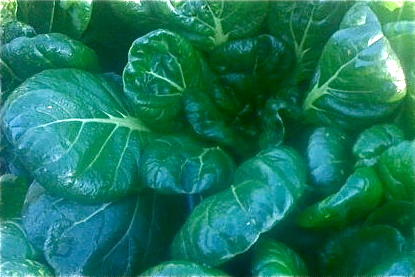| An Uncommon Garden |  |
| Earth to Kitchen: Mustard family greens called Brassicas pop with fresh flavors and big yields. |
| By John Lyons | Wednesday, 13 January 2010 | 18:12 |
|
EARTH TO KITCHEN: BRASSICAS The large group of plants belonging to the mustard family Cruciferae -- genus Brassica -- covers a range of common and not-so-common vegetables: from broccoli, cauliflower, cabbage, kale and Brussels sprouts to kohlrabi, rutabagas (Swedes), turnips, collards and choy. Brassicas are edible from flowers to roots. Depending on the plant, cooks prepare the stems (kohlrabi, choy), leaves (cabbage, choy, mustard, kale and collards), flowers (cauliflower, broccoli), roots (turnips and rutabagas) and seeds (mustard and rape). Rich in potassium, soluble fiber, folic acid and vitamins C and K, these vegetables are an absolute must in a daily diet. When home-grown, the taste and vitality of the vegetable is unsurpassed. GrowingBrassicas are quite easy to grow, though knowing the correct soil type is important. Most prefer a rich, well-draining soil that has been prepared with well-rotted manure and compost. Ideally the soil should be slightly acidic. Adding lime can increase the ph and adds calcium and magnesium to the crop. In Southern California, the ideal time to plant the winter garden is November onward when planting established plants, or as early as August when starting from seed. Southern Californians can continue to plant in succession through late January, but in the rest of the country Brassicas should be grown in early spring. Brassicas need their space in gardens. They grow large -- albeit slowly -- but eventually their habit of spreading can shade anything planted too close. When harvested, the yield will be substantial, especially with cabbages. Broccoli will form a main head, which should be removed; this will prompt the plant to produce side shoots that can be harvested for many weeks. Turnips can be easily grown from seed, just remember to thin out the plants to a 5-inch spacing once the plants reach 3 to 4 inches. (The removed plants can, of course, be eaten as turnip greens.) Allow extra garden space for a succession of plantings every six weeks and you'll have a steady supply of fresh vegetables throughout the season. PestsThere are a few really pernicious pests that enjoy eating these plants. The insidious, soil-borne fungal disease commonly known as club root is one of the most serious. If your soil becomes infected, this disease can remain in your garden for many years. A great advantage in growing brassicas from seed is that you avoid accidentally bringing such a disease into your garden via nursery-bought seedlings. The cabbage white butterfly is another opportunistic pest that can wreak havoc in crops. The butterfly lays large amounts of eggs, and its voracious caterpillars render leaves skeletal in a matter of days. An organic solution is a spray of Bt (bacillus thuringiensis), a parasitic bacterium that effectively kills the caterpillars when ingested. Such products can be found at most garden stores and are applied through spraying. Another solution: Cover the crop with fine netting to physically prevent the butterfly from gaining access to the plants. Aphids also can congregate in large amounts and be effectively controlled by a short, sharp blast of water from the hose. Finally, some of these plants may be eaten by rabbits and birds, something problematic usually in rural areas. Again, netting is the best solution to keep animals away from plants. Heirloom and hybrid varietals for the gardenSelect breeding and hybridization has resulted in a wide array of choices within each variety, but it can be hard to find them all at nurseries. Seed companies are where you'll find a full complement of options.
Broccoli: Legend, Packman, Fiesta, De Cicco Broccoli raab: Zamboni, Spring Sorrento Kale: Winter Red, Nero di Toscana, Improved Dwarf Siberian Brussels sprouts: Long Island Improved, Vancouver, Rubine Collards: Champion, Flash, Georgia Mustard (red and green): Southern Giant Curled, Osaka Red, Green Wave Turnips: Gold Ball, Purple Top Globe, Seven Top Choy: Pac Choi, Bok Choy, Ching-Chiang, Tatsoi Cabbage (red and green): Early Jersey Wakefield, Ruby Ball, Red Acre, Copenhagen Market, Savoy Kohlrabi: Dyna, Kongo, Purple Vienna Cauliflower: Snowball Early, Self Blanche, Cheddar, Snow Crown Rutabagas: Marian, Laurentian, Champion Collet Rouge
John Lyons is the founder of Earthmatters, a gardening school in Los Angeles' Silver Lake neighborhood, and The Woven Garden, a firm specializing in edible landscaping. He has written on gardening for the Los Angeles Times and California Gardener. Photo by Ledette Gambini |

